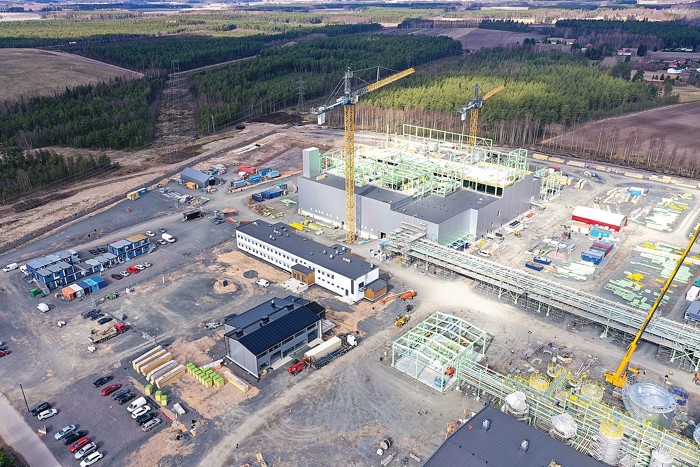Advertisement
Grab your lab coat. Let's get started
Welcome!
Welcome!
Create an account below to get 6 C&EN articles per month, receive newsletters and more - all free.
It seems this is your first time logging in online. Please enter the following information to continue.
As an ACS member you automatically get access to this site. All we need is few more details to create your reading experience.
Not you? Sign in with a different account.
Not you? Sign in with a different account.
ERROR 1
ERROR 1
ERROR 2
ERROR 2
ERROR 2
ERROR 2
ERROR 2
Password and Confirm password must match.
If you have an ACS member number, please enter it here so we can link this account to your membership. (optional)
ERROR 2
ACS values your privacy. By submitting your information, you are gaining access to C&EN and subscribing to our weekly newsletter. We use the information you provide to make your reading experience better, and we will never sell your data to third party members.
Pollution
BASF battery project delayed because of environmental concerns
Other firms building battery materials plants in the US and Europe could face similar permitting hurdles
by Matt Blois
February 29, 2024
| A version of this story appeared in
Volume 102, Issue 7

A Finnish court has ordered BASF to delay the opening of a battery materials plant in Harjavalta, Finland, after environmental groups argued that the company’s plan for dealing with sulfate waste isn’t sufficient. Analysts warn that similar environmental issues could slow other firms as they race to build battery supply chains in Europe and North America.
BASF’s Finnish plant is a key piece of a battery supply chain the company is trying to establish in Europe. It will be able to produce 30,000 metric tons (t) per year of precursors for battery cathodes. BASF will convert the precursors into cathode powders at a facility it commissioned last year in Schwarzheide, Germany.
Many of the materials used to make cathode precursors are sulfates of metals such as nickel and cobalt. Robert Baylis, principal at the battery supply chain consulting firm Carding Mill, says a caustic like sodium hydroxide is generally used to remove the sulfur component, a process that yields metal hydroxides and sodium sulfate waste.
Baylis says Finland has relatively permissive regulations regarding sulfate emissions because of the country’s paper and pulp industry, which also generates sodium sulfate. Several companies, including Umicore and CNGR Advanced Material, also plan to make cathode precursors there.
Finnish environmental groups have raised concerns about the environmental impact of these projects. Mari Granstörm, a former BASF chemist who helped the group Puhtaan Meren Puolesta contest the firm’s environmental permit, says BASF’s initial plan to discharge treated wastewater containing sodium sulfate into a river would have harmed aquatic life. “This river is very unique when you look at the biodiversity,” she says.
Puhtaan Meren Puolesta wants BASF to build a facility to crystallize sodium sulfate to sell into detergent or fertilizer markets, as some other firms plan to do. In 2021, Northvolt agreed to supply 200,000 t of sodium sulfate from its battery facility in Sweden to Cinis Fertilizer. “There are a lot of sodium sulfate crystallization units around the world,” Granstörm says. “It’s purely, ‘Are you willing to invest in this unit?’ ”
After challenges to the initial environmental permit, BASF proposed a wastewater management plan in 2022 that included a crystallizer. But the company said it would take at least 18 months to build and wouldn’t be operational before the main plant started up. In the interim, BASF planned to avoid emissions into the river by shipping wastewater containing sodium sulfate to another company for disposal. Puhtaan Meren Puolesta claims that intermediary would have pumped the wastewater into the Baltic Sea, a move the group considers unacceptable.
A BASF spokesperson says the company is waiting for the judicial process to play out before deciding on next steps or timing for the crystallization plant. BASF says that the crystallizer would almost completely eliminate sodium sulfate from the cathode precursor plant’s wastewater and that it hopes the courts will recognize its interim plan as adequate.
Baylis cautions that the market for powdered detergents isn’t growing and may not be able to absorb all the waste from the numerous battery materials plants being built in the US and Europe. “There are buyers. There’s just not many of them,” he says. “It’s hard to get rid of.”
Other options include regenerating sodium sulfate into sulfuric acid and sodium hydroxide, but the process usually produces low-quality chemicals, Baylis says. Firms such as AquaMetals, Nano One Materials, and 6K are trying to develop cathode production and battery recycling technologies that avoid sulfates. “Everybody’s working on something different,” Baylis says, “but it’s going take time.”


Join the conversation
Contact the reporter
Submit a Letter to the Editor for publication
Engage with us on Twitter